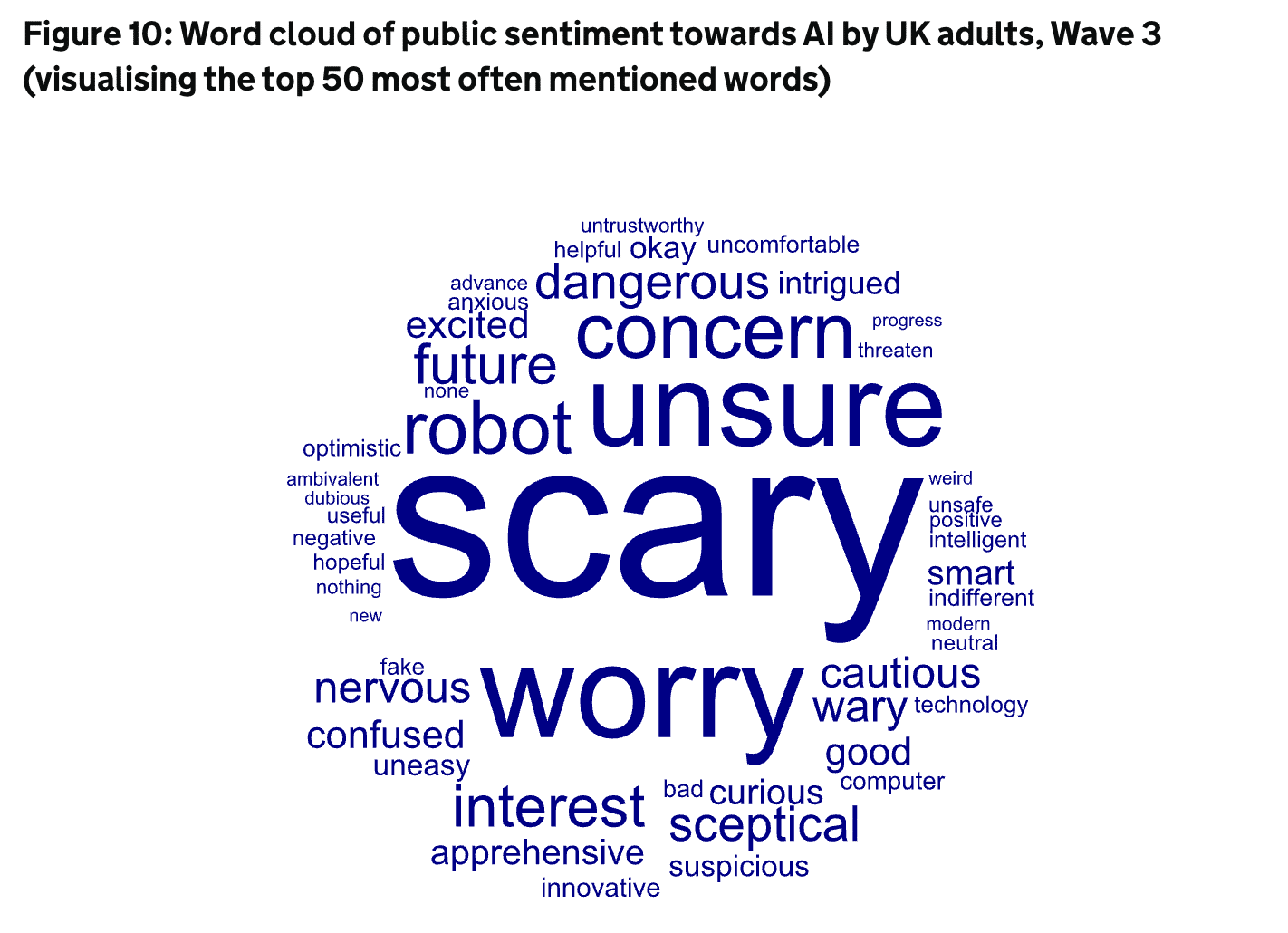
As businesses race to adopt artificial intelligence, many struggle with a crucial question: How can they harness this powerful technology without losing the trust of their customers and employees?
Recent high-profile AI failures, like Google’s flawed AI Overviews, have made headlines, leaving the public wary of AI’s potential risks.
With trust being harder to earn and easier to lose, even a small misstep could damage your brand’s reputation, eroding years of hard-earned loyalty.
This article explores how businesses can embrace AI while keeping trust and human values at the core. By preparing for the risks and implementing safeguards, you can confidently integrate AI into your business, ensuring innovation benefits your team, your customers and your brand.
Navigating public perception and trust in AI
The public’s uncertainty and anxiety about AI is evident.
A February 2024 UK Government research project surveyed the top 50 words UK adults associate with AI, with “scary,” “unsure,” “worry” and “concern” ranking highest.

Our love of fiction, where machines often take over, has likely fueled this worry.
People value human empathy and understanding in conversations, making the idea of machines creating content a new and unsettling concept in reality.
From a business perspective, 72% of businesses are using AI in at least one business function, McKinsey’s State of AI report found.
Perhaps unsurprisingly, the report found that inaccuracy was the number one risk associated with using generative AI – which is why the topic of trust is so important.
When it comes to brand loyalty, humans might not be as loyal as you think, 71% of people switch brands at least once a year and 70% switch for higher quality. Research shows that we tend to have five brands in our consideration set at any time.
Let’s explore trust from a human behavior perspective and how it’s built between businesses and consumers.
As we examine each concept, I’ll offer tips on how your business can apply these ideas when adopting AI.
Demonstrate competence
If consumers do not feel a product or service meets the required standards, they are likely to question the business’s competence. This can happen anytime, not just when a customer is new to a brand or business.
An ongoing commitment to demonstrating competence is critical for retaining trust.
There can be an air of arrogance when a brand feels this is no longer a requirement within a relationship and can often lead to the termination of a relationship – which, especially in a B2B world, is often unexpected by the brand.
How do you ensure a commitment to high standards?
In my business, we use the acronym “WAGOLL,” which stands for “what a good one looks like.”
Our WAGOLLs form part of our standards, ensuring everyone in the business has access to what our best work looks like.
If you don’t set the bar, how will the team know exceptional work from good work? This is relevant to any size business where a team is employed.
But how do you show this externally?
Encourage customer reviews, both positive and negative. You learn more from the unhappy ones.
Create a feedback culture within your team and ensure there’s a clear way to share insights across the business. You could also set up a client steering group – a panel of key customers to give feedback on new products, services and processes.
In the context of AI, if your brand suddenly loses its human touch and lets the machines run away with the content, this could be extremely damaging if not executed with care.
But on the flip side, if you embrace AI to help you categorize and summarize feedback from customers to make it more actionable or to check work completed against a WAGOLL, suddenly, it is an enabler of competency.
Be an authority on your specialist subjects
Being an authority in your space builds confidence, not only for prospects but also for customers.
When a brand has a trusted voice, be that in the content they share on their owned channels or in comments they give via third parties, seeing authoritative content and views reminds your audience that you are experts at what you do.
There are so many great ways to do this, from your organic social strategy to your PR strategy.
Staying updated on trends in your sector and sharing your opinions – or even leading the conversation – is a great way to build a personal or business profile.
Balancing the business voice with strong individual leaders who are willing to speak out can boost your impact even more.
What if you trained an AI assistant to spot opportunities for your business to comment on industry trends and then briefed an influential leader?
What if you used AI to analyze big data and identify trends for your next content story? AI helps humans focus on what they do best.
Dig deeper: How blogging builds trust and brand loyalty in the age of AI
Deliver consistent experiences
This is closely aligned with competence and authority.
Behaviorally, it is difficult for individuals to trust businesses when the message, service or product is inconsistent.
There is a reason why templated and process-driven businesses like McDonald’s have been so successful.
For the customer, the experience, expectations and execution are always the same, bringing comfort and trust.
How can you bring consistency to your approach?
Looking through your recent customer feedback with a lens for consistency can be a great starting point for ideas.
Depending on the scale of your business it can be tricky to get the right view on whether the experience is consistent, so you need to architect a way to find this out.
Could you train your AI assistant to find ways to improve consistency from reviews?
This task might take a human days or weeks, but AI can quickly present opportunities for your team to act on.
Bring transparency at the right time, in the right way
The fundamental core of understanding human behavior is to remember that we are all human and, therefore, not perfect.
A brand or business is made up of humans, and therefore, there is always the potential for mistakes.
A business that doesn’t make a mistake is not likely to innovate or grow. We should expect mistakes. However, how you deal with mistakes and how you communicate greatly impacts trust.
It’s crucial to have a clear, audience-focused process for transparency that builds trust, not fear.
Knowing when to be transparent, how to deliver the message and how to manage expectations ensures that trust remains strong during a crisis.
For the senior teams across innovation and communications, there should always be a plan for “what if” scenarios.
When building out a strategy to embrace AI more in your business, there will no doubt be risk assessments completed. These need to be shared with the communications team to plan for the “what if.”
Could AI support your business in modeling the potential issues from your risk assessments?
Can you bring transparency to your communications to demonstrate where AI is used and where humans take the lead?
Dig deeper: How AI is reshaping the content creator industry
Leverage social proof with UGC
In a world where everyone is a “content creator,” everyone can share opinions online, whether through social media, news outlets, or websites.
But with misleading deepfakes and AI-generated content, it’s harder than ever to know what to trust.
Some people are cautious, while others might not realize the information they see is often tailored to their interests by algorithms, creating an echo chamber.
Monitoring what people say about your brand is essential, but you can go further by encouraging user-generated content.
Reviews are crucial, as we rely heavily on others’ opinions to make decisions. However, don’t assume people will leave reviews on their own. You have to actively ask for them.
Be strategic. Remind customers when you’ll ask for feedback and follow up if they don’t respond.
Framing your request helpfully, like, “Many customers like you have shared their reviews to help others,” can also encourage participation.
Once you gather feedback, share how you’ve used it to improve. People are more likely to provide input if they know it leads to real change.
AI can assist with this by monitoring brand mentions, analyzing feedback and even testing different approaches to find the best way to ask for reviews.
Choosing the right messenger for the message
The “messenger effect” is a behavioral nudge that focuses on who delivers a message.
For instance, if I, as the owner of Reflect Digital, praise the company, potential customers may be skeptical. However, if a satisfied client shares their experience, it feels more trustworthy.
On the other hand, if there’s a business issue, hearing from me as the CEO will carry more weight than if it came from a junior team member. Choosing the right person for each message is crucial for building trust.
Mapping out who in your business or network is best suited to deliver specific messages can make this strategy more effective. Having the right people, both internally and externally, speak on key topics ensures clarity and trust.
When it comes to AI, having internal leaders explain how AI benefits customers can position your business well. Transparency and using the right messengers to highlight positive impacts will help build trust.
The right format for the message
It’s not just about who delivers the message, but how it’s delivered.
For example, Google addressed recent AI issues with a written statement from Liz Reid, VP of Google Search. However, a video statement could have made a bigger impact.
I recently experienced this firsthand with Ryanair. Before my flight, I received an app alert with a video filmed live from an air traffic control room.
The speaker confidently explained potential delays due to strikes in Europe, making the message feel timely and personal. It gave me confidence as a customer.
The way you present information – whether through video, written statements, or other formats – matters.
Video, in particular, can be a powerful tool to build trust with your audience. While it may seem like a big effort at first, it’s easy to implement and can have a significant impact.
A good next step is to review the communication formats and channels your business uses. Ensure your team understands what’s possible so you can make the most of each message opportunity.
AI can help by creating an internal assistant that knows your audience, channels and best messengers. This tool can guide your team in choosing the right format and person for each message, especially in larger organizations where not everyone knows each other.
Being human: Demonstrating empathy and authenticity
Empathy and authenticity are key to building trust with your audience. Understanding how they feel and the impact of your business decisions helps create a more human approach.
At a recent event, marketing leaders discussed the growing importance of authenticity. While people have always valued authenticity, the ability to demonstrate it has improved – and this is where AI poses a risk. If businesses rely too much on AI, they may lose the human touch.
To ensure authenticity, you need to align your business values with what your audience cares about. If there’s a disconnect, it’s crucial to address it before embracing AI.
Train any AI tools on your company values, but always have a human check content before it goes public.
For live AI interactions, like chatbots, ensure users know they’re speaking to AI and offer a way to connect with a human if needed.
AI offers huge potential, but businesses must balance innovation with empathy. By understanding the risks and preparing for them, you can harness AI’s power without losing trust.
Keep human values at the core, and your business will succeed in the age of AI.
Dig deeper: 3 ways to add a human touch to AI-generated content
from Search Engine Land https://ift.tt/ZHt6Fjr
via IFTTT
No comments:
Post a Comment